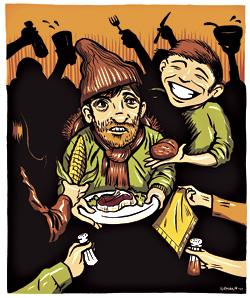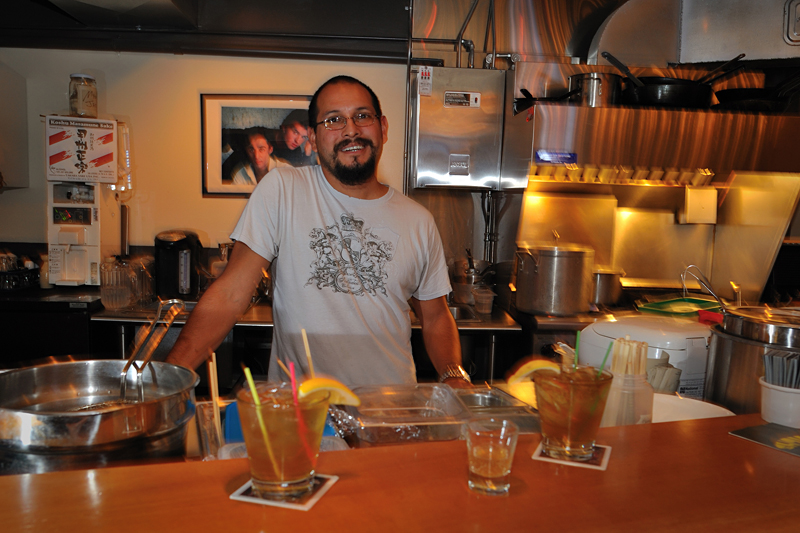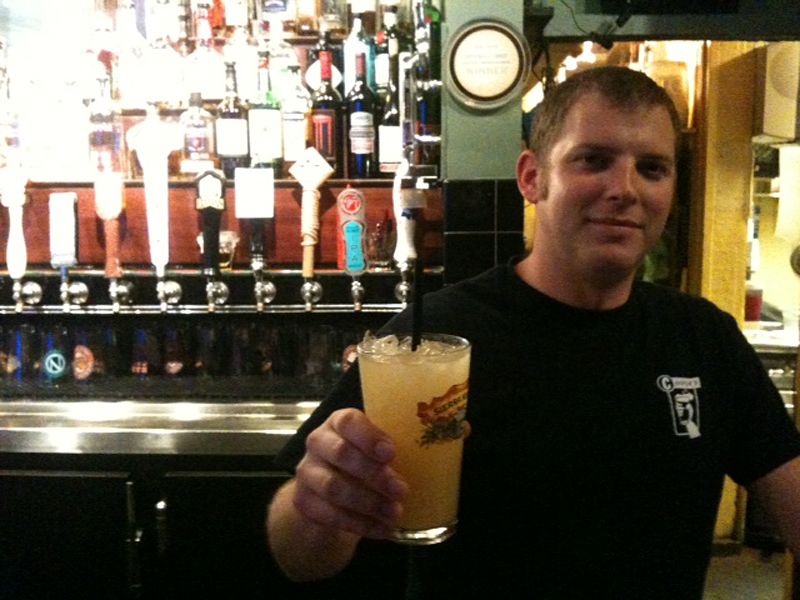A little before 6:30 p.m. on Thanksgiving night, 25 people from Woodinville’s Redwood Hills Church are waiting outside the Union Gospel Mission near Pioneer Square. Unlike the group of downtrodden men who are also gathered there in the cold, the church members aren’t waiting for a free meal. They are there to serve. But because of a mixup in scheduling, another large group of volunteers is still inside. So the church members stand out on the sidewalk for a half-hour.
Once inside, the volunteers pick up latex gloves and red aprons. Standing among them is mission staffer Sue Hollman, who rushes through the rules, dishes out tasks, and tries to answer questions before getting back to the door to take tickets from people waiting for a Thanksgiving meal. Having all the volunteers around “does get crazy,” she says.
Most nights people eating at the mission walk through a cafeteria-style line and serve themselves, but tonight, in order to make the meal special—and make use of all the volunteers—they’re served restaurant-style. With a little more than 100 people filing in from the chapel to eat, there’s about a 4-1 ratio of diners to volunteers. You won’t get service this attentive anywhere else in the city.
Even after assigning people to put the food on plates, others to carry the plates out, and others to stand guard with pitchers of water, there are enough volunteers to have two women making rounds with tubs of whipped topping in case anyone requests it for their pie. Most of the volunteers pend much of the dinner trying to stay out of each other’s way, moving between the cafeteria-style tables of the dining hall.
There easily could have been even more people coming in to serve that night. “We could have brought 40,” Redwood Hills’ lead pastor, John Vertefeuille, says. But the mission gave Redwood Hills just 25 volunteer positions. The church had to create a waiting list among its members.
The mission, too, has a waiting list. Its slots for holiday volunteers started filling up in September, and by October, waiting lists had been set up. Ironically, September is the same month that the mission has the fewest volunteers show up to help, according to volunteer manager Carol Osher. Last year in September, the mission only had about one-third as many volunteers as in December, she says.
When the river of volunteers during the holidays slows to a trickle at other times, mission staff find themselves calling anyone they can think of, she says. One crunch time, for example, is August, when the participants in a mission rehabilitation program—who normally fill in when the mission is short on volunteers—go away for a week’s retreat. People aren’t exactly clamoring to fill the spots at that time of year. “We have really had to scramble,” Osher says, adding that when the mission gets desperate, it starts asking employees to come in early or stay late to help out.
The problem of seasonal feast-or-famine volunteer participation is typical for service nonprofits, says Cory Sbarbaro, founder of Turnpoint Consulting, a local company that advises such organizations. While most groups will find a way to make it work without the volunteers during the off-season, he says, they end up spending more time and money on recruiting and training additional volunteers for onetime appearances to fill in when they’re coming up short. “It’s not unlike adding an employee to a business.”
Rather than adding to the volunteer crunch in November and December, people should take a less direct approach to giving during the holidays. Sbarbaro recommends sitting down with family and friends and creating a list of places you might like to volunteer, selecting one, and making a yearlong commitment. When people volunteer for a day, “I think you get a glimpse,” he says. “A repeated volunteer experience will give you a more comprehensive look at the needs that people in our community are facing.”
Indeed, some service organizations have started requiring those kinds of commitments. Individual volunteers at the Downtown Emergency Service Center, which provides emergency shelter and aids people in finding more permanent housing, must agree to serve six months, says volunteer coordinator Janelle Rothfolk. They do schedule a few one-shot group projects throughout the year, like deep-cleaning facilities or helping with major file reorganizations, but “I don’t think I can take any more groups for the holidays,” she adds.
Operation Nightwatch, a Seattle nonprofit that helps people find shelter and works to get them into affordable housing, doesn’t have such specific requirements, says Deputy Director Ann Sakaguchi, but it does ask potential volunteers to make a regular commitment rather than come in for a single appearance.
Of course, most people want to give in some tangible, hands-on way, to look the recipient of their benevolence in the eye. But for most organizations, Sbarbaro says, the best onetime holiday contribution you can make is a check. It allows service organizations to cover their needs as they see fit throughout the year. Most of the mission’s $14.4 million operating budget comes from individual contributions rather than government or foundation grants or large business contributions, according to its most recent annual report.
Sakaguchi agrees that money is often the most helpful thing, but adds that if you feel absolutely compelled to do something more physical than signing your name to a check, feel free to bake cookies at home, bring them down to the shelter, and just drop them off. “We love that,” she says.








